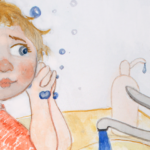A rhythmic three-line story pattern could help children cope in the time of the coronavirus, said Linda Cooper, author of the children’s picture book, I Don’t. I Don’t. I Do! The picture book aims to teach children a timeless truth: That often you first have to do what you don’t want to do so that you can then do what you do want to do. This approach can be easily … [Read more...] about Children’s Picture Book Author On Helping Kids During COVID-19
Ages 3-5
I Don’t. I Don’t. I Do! Offers Kids A Bedtime Story Wrapped In A Timeless Truth
What children often have difficulty grasping is that they sometimes have to do what they don’t like — before they can do what they do like. This little secret is illuminated in I Don’t. I Don’t. I Do!, the first illustrated children's ebook from Hungry Mutt productions. The picture book, available on Amazon Kindle and Apple Books, was written by former … [Read more...] about I Don’t. I Don’t. I Do! Offers Kids A Bedtime Story Wrapped In A Timeless Truth


